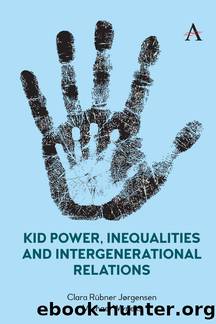Kid Power, Inequalities and Intergenerational Relations by Clara Rübner Jørgensen Michael Wyness

Author:Clara Rübner Jørgensen, Michael Wyness [Clara Rübner Jørgensen, Michael Wyness]
Language: eng
Format: epub
Tags: Social Science, Sociology, General, Social Theory, Children's Studies
ISBN: 9781785277719
Google: PU05EAAAQBAJ
Publisher: Anthem Press
Published: 2021-07-06T04:21:04+00:00
Discussion and Conclusion
In constructing our theory of kid power, one of the key features is the role of children as mediators, which connects children with various groups of adults with varying degrees of authority. In this chapter we have focused on themes that relate to the broader issue of childrenâs interstitial position as mediators within and between households and the linking up of families that are perhaps culturally alienated from broader and newer external contexts. While occupying this position might challenge a particular conception of generational power, the idea that children can mediate in different ways with respect to family, at the very least, complicates the common notion of a binary structural and generational position of children as subordinates and dependants (Prout and James, 1997). In effect, the idea of the child as mediator challenges the bi-nuclear family and by implication binary zero-sum notions of power.
There are three common threads that run through the discussions on children and divorce, children and migration, and CHHs. First, these are contexts of childhood and familial adversity underpinned by ongoing material poverty, problems of chronic illness and levels of cultural discrimination. These structural factors are overlain by new sets of familial circumstances to which families have had to adjust. If children do assume powerful positions, they are shaped by adverse sets of circumstances. More mundanely, children are adjusting to changing economic and social circumstances largely outside their control.
Second, all three examples involve issues of separation and dislocation of children from their families. For divorcing parents there are varying levels of distance between children and their biological parents. The separation is social, emotional and, in some instances, economic. Childrenâs mediation here is about managing lines of communication and physical contact between parents in separate households. For migrant children and their families, there is a separation from their homelands and a cultural and linguistic dislocation which children sometimes manage more effectively than their parents. Children position themselves between home and host country, offering practical support in helping their families to settle. In the case of CHHs, childrenâs separation from biological parents is permanent, robbing them of an economic, emotional and support network that many children take for granted. Agendas for living and for growing up are normally established within families for children by parents. Where parents are missing or where the parental dynamic radically changes within the home, mediation here often means children reaching out to other adults, households and organisations; taking on extra responsibilities; negotiating tasks; and generally having greater involvement with a wider range of other adults.
A third common factor is the way that these families challenge a dominant bi-nuclear family driven by structural factors, including poverty, inequality and discrimination. The families that we have discussed in this chapter have difficulties thriving within a context of global capitalism, inequality, discrimination and, in the case of CHHs, pandemics. In adapting to these forces, families and children are having to challenge cultural and social norms about family. We have provided illustrations of the way that generational
Download
This site does not store any files on its server. We only index and link to content provided by other sites. Please contact the content providers to delete copyright contents if any and email us, we'll remove relevant links or contents immediately.
Cecilia; Or, Memoirs of an Heiress — Volume 1 by Fanny Burney(32022)
Cecilia; Or, Memoirs of an Heiress — Volume 3 by Fanny Burney(31436)
Cecilia; Or, Memoirs of an Heiress — Volume 2 by Fanny Burney(31380)
The Great Music City by Andrea Baker(30641)
We're Going to Need More Wine by Gabrielle Union(18605)
All the Missing Girls by Megan Miranda(14591)
Pimp by Iceberg Slim(13717)
Bombshells: Glamour Girls of a Lifetime by Sullivan Steve(13665)
Fifty Shades Freed by E L James(12886)
Talking to Strangers by Malcolm Gladwell(12813)
Norse Mythology by Gaiman Neil(12785)
For the Love of Europe by Rick Steves(11331)
Crazy Rich Asians by Kevin Kwan(8860)
Mindhunter: Inside the FBI's Elite Serial Crime Unit by John E. Douglas & Mark Olshaker(8663)
The Lost Art of Listening by Michael P. Nichols(7125)
Enlightenment Now: The Case for Reason, Science, Humanism, and Progress by Steven Pinker(6852)
The Four Agreements by Don Miguel Ruiz(6284)
Bad Blood by John Carreyrou(6252)
Weapons of Math Destruction by Cathy O'Neil(5800)
